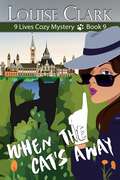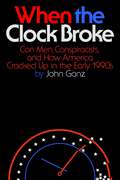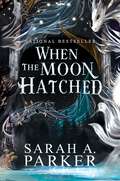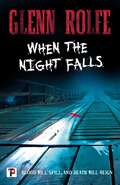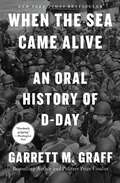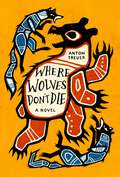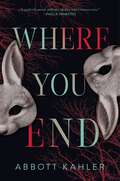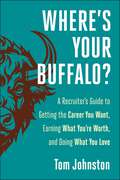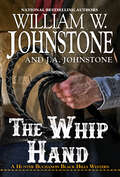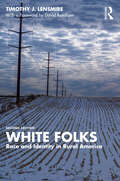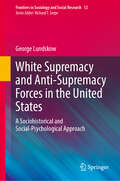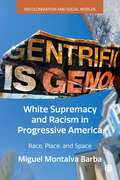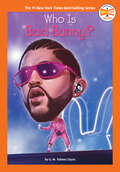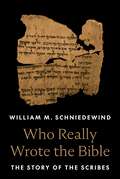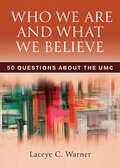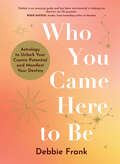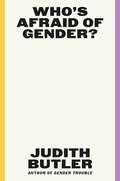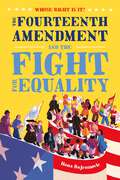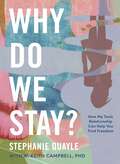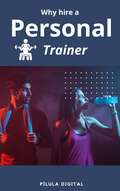- Table View
- List View
When the Cat's Away (The 9 Lives Cozy Mystery Series #9)
by Louise ClarkStormy the Cat Investigates Murder of Unscrupulous Businessman in When the Cat’s Away, a Cozy Mystery from Louise Clark—Ottawa, Ontario, Canada—Quinn and Christy's tranquil family vacation is cut short by an urgent plea from Tamara, Quinn’s ex-girlfriend. Her father, Todd Ahern, stands accused of murdering a business associate, Ralph Sharpe, following a violent argument. Ralph and Todd were board members for a non-profit but had strongly differing views on direction and management. Now chief suspect, Todd swears he is innocent.Determined to uncover the truth, Quinn, Christy, and their astute cat Stormy, delve into Ralph’s background. Their investigation uncovers not only widespread dislike for Ralph, but also for his ruthless business practices that have harmed far too many people.As the evidence mounts, they orchestrate a daring confrontation to unmask the real murderer and clear Todd's name, proving once again that some mysteries just need a cat's touch.Publisher Note: The 9 Lives Cozy Mysteries, while containing some very mild profanity, will be enjoyed by readers of clean and wholesome cozy mysteries. Cat lovers and those fond of all things feline, as well as readers of Amanda Lee, Denise Grover Swank, Rita Mae Brown’s Sneaky Pie Brown Mysteries, and Shirley Rousseau Murphy’s Joe Grey Mysteries, will not want to miss this series.The 9 Lives Cozy MysteriesThe Cat Came BackThe Cat’s PawCat Got Your TongueLet Sleeping Cats LieCat Among the FishesCat in the LimelightFleece the CatListen to the CatWhen the Cat's AwayAbout The Author: The author of the 9 Lives Cozy Mystery Series, Louise Clark has been the adopted mom of a number of cats with big personalities. The feline who inspired Stormy, the cat in the 9 Lives books, dominated her household for twenty loving years. During that time he created a family pecking order that left Louise on top and her youngest child on the bottom (just below the guinea pig), regularly tried to eat all his sister’s food (he was a very large cat), and learned the joys of travel through a cross-continent road trip. The 9 Lives Cozy Mystery Series—as well as the single title mystery, A Recipe For Trouble, are set in Louise’s hometown of Vancouver, British Columbia, and elsewhere throughout Canada.
When the Clock Broke: Con Men, Conspiracists, And How America Cracked Up In The Early 1990s
by John GanzWith the Soviet Union extinct, Saddam Hussein defeated, and U.S. power at its zenith, the early 1990s promised a “kinder, gentler America.” Instead, it was a period of rising anger and domestic turmoil, anticipating the polarization and resurgent extremism we know today. In When the Clock Broke, the acclaimed political writer John Ganz tells the story of America’s late-century discontents. Ranging from upheavals in Crown Heights and Los Angeles to the advent of David Duke and the heartland survivalists, the broadcasts of Rush Limbaugh, and the bitter disputes between neoconservatives and the “paleo-con” right, Ganz immerses us in a time when what Philip Roth called the “indigenous American berserk” took new and ever-wilder forms. In the 1992 campaign, Pat Buchanan's and Ross Perot’s insurgent populist bids upended the political establishment, all while Americans struggled through recession, alarm about racial and social change, the specter of a new power in Asia, and the end of Cold War–era political norms. Conspiracy theories surged, and intellectuals and activists strove to understand the “Middle American Radicals” whose alienation fueled new causes. Meanwhile, Bill Clinton appeared to forge a new, vital center, though it would not hold for long. In a rollicking, eye-opening book, Ganz narrates the fall of the Reagan order and the rise of a new and more turbulent America.
When the Clock Broke: Con Men, Conspiracists, and How America Cracked Up in the Early 1990s
by John GanzAN INSTANT NEW YORK TIMES BESTSELLER | National Indie Bestseller"Terrific . . . Vibrant . . . When the Clock Broke is one of those rarest of books: unflaggingly entertaining while never losing sight of its moral core." —Jennifer Szalai, The New York Times"When the Clock Broke is leagues more insightful on the subject of Trump’s ascent than most writing that purports to address the issue directly." —Becca Rothfeld, The Washington Post"Lively and kaleidoscopic." —Andrew Marantz, The New Yorker"John Ganz is the most important young political writer of his generation—just the one our dark moment needs." —Rick PerlsteinA revelatory look back at the convulsions at the end of the Reagan era—and their dark legacy today. With the Soviet Union extinct, Saddam Hussein defeated, and U.S. power at its zenith, the early 1990s promised a “kinder, gentler America.” Instead, it was a period of rising anger and domestic turmoil, anticipating the polarization and resurgent extremism we know today. In When the Clock Broke, the acclaimed political writer John Ganz tells the story of America’s late-century discontents. Ranging from upheavals in Crown Heights and Los Angeles to the advent of David Duke and the heartland survivalists, the broadcasts of Rush Limbaugh, and the bitter disputes between neoconservatives and the “paleo-con” right, Ganz immerses us in a time when what Philip Roth called the “indigenous American berserk” took new and ever-wilder forms. In the 1992 campaign, Pat Buchanan's and Ross Perot’s insurgent populist bids upended the political establishment, all while Americans struggled through recession, alarm about racial and social change, the specter of a new power in Asia, and the end of Cold War–era political norms. Conspiracy theories surged, and intellectuals and activists strove to understand the “Middle American Radicals” whose alienation fueled new causes. Meanwhile, Bill Clinton appeared to forge a new, vital center, though it would not hold for long. In a rollicking, eye-opening book, Ganz narrates the fall of the Reagan order and the rise of a new and more turbulent America.
When the Moon Hatched: A Novel (The Moonfall Series #1)
by Sarah A. ParkerTHE OVERNIGHT VIRAL SENSATION AND NATIONAL BESTSELLER The bestselling phenomenon, When the Moon Hatched, is a fast-paced fantasy romance featuring an immersive, vibrant world with mysterious creatures, a unique magic system, and a love that blazes through the ages.The Creators did not expect their beloved dragons to sail skyward upon their end. To curl into balls just beyond gravity’s grip, littering the sky with tombstones. With moons. They certainly did not expect them to FALL.As an assassin for the rebellion group Fíur du Ath, Raeve’s job is to complete orders and never get caught. When a rival bounty hunter turns her world upside down, blood spills, hearts break, and Raeve finds herself imprisoned by the Guild of Nobles—a group of powerful fae who turn her into a political statement.Crushed by the loss of his great love, Kaan Vaegor took the head of a king and donned his melted crown. Now on a tireless quest to quell the never-ebbing ache in his chest, he is lured by a clue into the capitol’s high-security prison where he stumbles upon the imprisoned Raeve …Echoes of the past race between them.There’s more to their story than meets the eye, but some truths are too poisonous to swallow."A wild ride that thrills as much as it enchants . . . This remarkable book is an instant classic.” — Thea Guanzon, New York Times bestselling author of The Hurricane Wars“When The Moon Hatched breathes new, beautiful life into the genre, as Sarah A. Parker weaves lyrical prose with undeniable chemistry. I laughed, I cried, I got everything out of this. It’s an absolutely stunning fantasy world that everyone should sink their teeth into.” — Raven Kennedy, internationally bestselling author of The Plated Prisoner series
When the Night Comes Falling: A Requiem for the Idaho Student Murders
by Howard BlumThe definitive, inside story of the Idaho murders from bestselling author Howard Blum, whose groundbreaking coverage of the story was nominated for a Pulitzer Prize.Timed for a trial that will capture national attention, When the Night Comes Falling examines the mysterious murders of the four University of Idaho students. Having covered this case from its start, Edgar award winning investigative reporter Howard Blum takes readers behind the scenes of the police manhunt that eventually led to suspected killer, Bryan Christopher Kohberger, and uncovered larger, lurid questions within this unthinkable tragedy.Reminiscent of the panoramic portraiture of In Cold Blood and The Executioner’s Song, When the Night Comes Falling offers a suspenseful, richly detailed narrative that will have readers transfixed.
When the Night Falls
by Glenn Rolfe&“Rolfe&’s writing is a wonderful throwback to the fun and bloody days of paperback horror glory.&” — Richard Chizmar, New York Times Bestselling AuthorRocky Zukas lives with the ghosts of what happens when you fall in love with a monster. Lucky to be alive, Rocky roams his beachside hometown living on autopilot, waiting for life to start again.November Riley has never been far from the boy that stole her heart. She watches from the shadows, knowing she can never make things right between them, but never giving up on the chance they could try one more time.A new documentary is bringing Gabriel Riley, the Beach Night Killer, back to national consciousness. The dead serial killer has a trio of new fans that are ready to make Old Orchard Beach, Maine their home for the end of the summer season. When the new strangers in town discover Rocky&’s relationship to the past of one of their own, he becomes their number one target. Can November protect him, or will these other vampires prove too strong? When the night falls, blood will spill, and death will reign.
When the Sea Came Alive: An Oral History of D-Day
by Garrett M. GraffReal men fought for our freedoms. It’s time we fought for theirs. <P><P> Pete Hegseth joined the Army to fight extremists. Then that same Army called him one. The military Pete joined twenty years ago was fiercely focused on lethality, competency, and color blindness. Today our brass are following the rest of our country off the cliff of cultural chaos and weakness. <P><P> Americans with common sense are fighting this on many fronts, but if we can’t save the meritocracy of our military, we’re definitely going to lose everywhere else. <P><P> The War on Warriors uncovers the deep roots of our dysfunction—a society that has forgotten the men who take risks, cut through red tape, and get their hands dirty. The only kind of men prepared to face the dangers that the Left pretends don’t exist. Unlike issues of education or taxes or crime, this problem doesn’t have a zip code solution. We can’t move away from it. We can’t avoid it. We have only one Pentagon. Either we take it back or surrender it altogether. <P><P> Combining his own war experiences, tales of outrage, and an incisive look at how the chain of command got so kinked, this book is the key to saving our warriors—and winning future wars. The War on Warriors must be won by the good guys, because when the shooting really starts, they’re the only ones who can save us. <p> <b>New York Times Bestseller</b>
Where Is Liam?
by Ellen GoodWhen a young schoolboy suddenly falls ill while playing in the local park, his concerned parents rush him to the hospital, leaving behind his cherished case filled with his favourite toys. The next day, his best friend visits the park to play, only to discover the abandoned toy case. Unable to find her friend, she decides to take the case home, intending to return it to him at school the following day. However, she soon learns the heartbreaking news that her dear friend is gravely ill and will require an extended stay in the hospital to recover. Determined to bring comfort and joy to her friend during this challenging time, she rallies her classmates to devise a plan to ensure he knows he is not forgotten.
Where Wolves Don't Die
by Anton TreuerEzra Cloud hates living in Northeast Minneapolis. His father is a professor of their language, Ojibwe, at a local college, so they have to be there. But Ezra hates the dirty, polluted snow around them. He hates being away from the rez at Nigigoonsiminikaaning First Nation. And he hates the local bully in his neighborhood, Matt Schroeder, who terrorizes Ezra and his friend Nora George. Ezra gets into a terrible fight with Matt at school defending Nora, and that same night, Matt’s house burns down. Instantly, Ezra becomes a prime suspect. Knowing he won’t get a fair deal, and knowing his innocence, Ezra’s family sends him away to run traplines with his grandfather in a remote part of Canada, while the investigation is ongoing. But the Schroeders are looking for him… From acclaimed author Anton Treuer comes a novel that’s both taut thriller and a raw, tender coming-of-age story, about one Ojibwe boy learning to love himself through the love of his family around him. P R A I S E "Where Wolves Don't Die will lift you up and not let you down. Anton Treuer knows how to tell a gripping story and the suspense doesn't let up for a single page. Along the way you'll learn about Ojibwe lifeways, languages, sharp jokes, gentle humor, and how to keep romantic love alive from youth to old age. I couldn't put this book down until I'd finished it, and then, I could not forget it." —Louise Erdrich, Pulitzer Prize Winner and owner of Birchbark Books "I am in awe, crying and smiling at the same time. Where Wolves Don’t Die is a love letter to our Ancestors. This beautiful story is full of cultural teachings and characters so familiar that I'm pretty sure we're related." —Angeline Boulley, #1 NYT bestselling author of Firekeeper’s Daughter "It is quite likely that I will never stop reading Where Wolves Don’t Die. First of all, it’s an excellent piece of writing, and second of all, each time that I would read through one section I would want to go back and read that section or another one over again. I enjoyed the writing so much because the author’s thoughts reflected mine in terms of what I knew my life to be and what I had hoped could have been. I think it is one of the best pieces of writing I have ever read." —The Hon. Senator Murray Sinclair, Chair of Canada’s Truth and Reconciliation Commission "A nuanced adventure centering family and growth." —Kirkus "Where Wolves Don’t Die gives voice to all of us who survived residential boarding school, visibility to all of us who love and live our language and culture, and hope to all good humans who quest for healing, connection, and love. Everyone should read this." —Dennis Jones, Nigigoonsiminikaaning First Nation Elder and Retired Instructor of Ojibwe, University of Minnesota and residential school survivor "Where Wolves Don’t Die will immerse you in the northern wilderness more completely than Hatchet, rivet you to a storyline faster than a Harry Potter book, and transport you into Indigenous culture more authentically and compellingly than anything in print. This is the best book I have ever read." —Charles Grolla, author of Binesi-dibaajimowinan: Ojibwe Bird Stories and Makazinataagewin: Ojibwe Style Moccasin Game "I have never read a book that so authentically portrayed the yearning we all feel for our culture, ancestors, families, and communities. Where Wolves Don’t Die had me laughing out loud, staying up late to absorb one chapter after another, and crying buckets of unrestrained joy. It left me proud to be Indian and so happy to be alive." —Chrissy Downwind, Vice President of American Indian Student Success & Campus Diversity Officer, American Indian Resource Center, Bemidji State University
Where You End: A Novel
by Abbott KahlerAn Amazon Top Book of the MonthA Good Morning America Buzz PickA Mary Calvi Book Club Pick“A perfectly paced, addictive thriller with a vicious twist.” —Paula HawkinsFrom bestselling nonfiction author Abbott Kahler comes a spellbinding fiction debut: an unusual form of amnesia upends the lives of identical twins, forcing them to face the indelible, dangerous shadow of the past.When Kat Bird wakes up from a coma, she sees her mirror image: Jude, her twin sister. Jude’s face and name are the only memories Kat has from before her accident. As Kat tries to make sense of things, she believes Jude will provide all the answers to her most pressing questions:Who am I?Where am I?What actually happened? Amid this tragedy, Jude sees an irresistible opportunity: she can give her sister a brand-new past, one worlds away from the lives they actually led. She spins tales of an idyllic childhood, exotic travels, and a bright future.But if everything was so perfect, who are the mysterious people following Kat? And what explains her uncontrollable flashes of violent anger, which begin to jeopardize a sweet new romance?Duped by the one person she trusted, Kat must try to untangle fact from fiction. Yet as she pulls at the threads of Jude’s elaborate tapestry, she has no idea of the catastrophe she’s inviting. At stake is not just the twins’ relationship, but their very survival.Intensely creepy and beautifully written, Abbott Kahler’s Where You End is an unforgettable tale of intrigue, revenge, and the quest for redemption.
Where's Your Buffalo?: A Recruiter's Guide to Getting the Career You Want, Earning What You're Worth, and Doing What You Love
by Tom JohnstonA veteran recruiter helps create a business plan for your career.Where&’s Your Buffalo? is a career management guide for any age and any career stage. It&’s a timely framework for finding, pursuing, and achieving employment that enables any reader to meet their professional and personal life goals. It&’s a practical path to help readers choose a career, get the job they want, earn what they are worth, and do what they love (or at least genuinely like).Where&’s Your Buffalo? shares the methodology that author Tom Johnston has developed over 35 years as a search consultant at some of the world&’s most influential firms. This book will help readers identify their perfect career (their &“Buffalo&”) and chart a course to reach it, including how to: Better understand your skills and talents Articulate what is important to you in a job and why Identify industries that will support what is important to you Determine your target destination (we can adjust course as conditions change) Research and understand the companies that can provide you with a path Build a targeted network to help you along the way Learn how to hunt for the job you want Only 1% to 2% of people in the world will have the chance to be coached by an executive recruiter. Where&’s Your Buffalo? is your chance.
The Whip Hand (A Hunter Buchanon Black Hills Western #4)
by William W. Johnstone J.A. JohnstoneJOHNSTONE COUNTRY. THE ULTIMATE KILLING GROUND.The latest action-packed installment in bestselling Western authors William W. Johnstone and J.A. Johnstone in the Hunter Buchanon Black Hills Western series.THE HILLS HAVE EYES The Buchanans are no strangers to hard times—or making hard choices. After losing a hefty number of livestock to a killer grizzly, Hunter Buchanan is forced to sell a dozen broncs down in Denver for some badly needed cash. Everything goes smoothly—until he&’s ambushed on the way home. The culprits are a murderous bunch of prairie rat outlaws, as dangerous as any Buchanan has ever tangled with. But Hunter is hell-bent on getting his money back. Even if means pursuing the thieves into Dakota Territory—where even deadlier dangers await . . . Meanwhile, Angus Buchanan has agreed to guide three former Confederate bounty hunters into the Black Hills, on the trail of six cutthroats who robbed a saloon and killed two men in Deadwood. This motley trio of hunters are as cutthroat as the cutthroats they&’re after. And it doesn&’t take long for Angus to realize they mean to slaughter him as well at the end of the trail . . . One family of ranchers. Two groups of cold-hearted murderers. So many ways to die.
White Folks: Race and Identity in Rural America (ISSN)
by Timothy J. LensmireWhite Folks explores the experiences and stories of eight white people from a small farming community in northern Wisconsin. Drawing on in-depth interviews with Delores, Frank, William, Erin, Robert, Libby, and Stan, as well as on his own experiences growing up in this same rural community, Lensmire creates a portrait of white people that highlights the profound ambivalence that has characterized white thinking and feeling in relation to people of color for at least the last two hundred years. White people’s relations to people of color and their cultures are characterized not just by fear, rejection, and violence, but also by attraction, envy, and desire. There is nothing smooth about the souls of white folks.This second edition of White Folks features a new foreword—by renowned critical whiteness studies scholar David Roediger—that places the book in historical and political context. It also includes an expanded discussion by Lensmire on doing research on race with white people.
White Poverty: How Exposing Myths About Race and Class Can Reconstruct American Democracy
by William J. Barber IIA generational work with far-ranging social and political implications, White Poverty, promises to be one of the most influential books in recent years. One of the most pernicious and persistent myths in the United States is the association of Black skin with poverty. Though there are forty million more poor white people than Black people, most Americans, both Republicans and Democrats, continue to think of poverty—along with issues like welfare, unemployment, and food stamps—as solely a Black problem. Why is this so? What are the historical causes? And what are the political consequences that result? These are among the questions that the Reverend Dr. William J. Barber II, a leading advocate for the rights of the poor and the “closest person we have to Dr. King” (Cornel West), addresses in White Poverty, a groundbreaking work that exposes a legacy of historical myths that continue to define both white and Black people, creating in the process what might seem like an insuperable divide. Analyzing what has changed since the 1930s, when the face of American poverty was white, Barber, along with Jonathan Wilson-Hartgrove, addresses white poverty as a hugely neglected subject that just might provide the key to mitigating racism and bringing together tens of millions of working class and impoverished Americans. Thus challenging the very definition of who is poor in America, Barber writes about the lies that prevent us from seeing the pain of poor white families who have been offered little more than their “whiteness” and angry social media posts to sustain them in an economy where the costs of housing, healthcare, and education have skyrocketed while wages have stagnated for all but the very rich. Asserting in Biblically inspired language that there should never be shame in being poor, White Poverty lifts the hope for a new “moral fusion movement” that seeks to unite people “who have been pitted against one another by politicians (and billionaires) who depend on the poorest of us not being here.” Ultimately, White Poverty, a ringing work that braids poignant autobiographical recollections with astute historical analysis, contends that tens of millions of America’s poorest earners, the majority of whom don’t vote, have much in common, thus providing us with one of the most empathetic and visionary approaches to American poverty in decades.
White Supremacy and Anti-Supremacy Forces in the United States: A Sociohistorical and Social-Psychological Approach (Frontiers in Sociology and Social Research #12)
by George LundskowThis book applies the most recent research in social psychology to decisive historical events that arguably built white supremacy as a cultural force, institutional system, and dominant social character. Simultaneously, the discussion considers the progressive counter-forces that have and continue to challenge white supremacy, and how this dialectical battle has brought the United States to the polarizations of the present day. The book builds a four-part argument. First, it considers the origins of white supremacy in the United States, and how some people uphold it today. Second, it discusses personality types that find white supremacy appealing. Third, it lays out the sociohistorical patterns that promoted white supremacy, rewarded people who practiced it, and created generations of people who find meaning and comfort in racist, misogynist, and heteronormative domination. Fourth, it discusses the social counterforces that challenge white supremacy and links these to personality types as well. Overall, the book examines how social character correlates with differing personality types, resulting in very different social movements, cultural expressions, political activities, and daily interactions.
White Supremacy and Racism in Progressive America: Race, Place, and Space (Decolonization and Social Worlds)
by Miguel Montalva BarbaThis book examines the connections between race, place, and space, and sheds light on how they contribute and maintain racial hierarchies. The author focuses on the White residents of Jamaica Plain, Massachusetts, which, according to the Cooks Political Report Partisan Voting Index, is the most liberal district in the state and 15th in the United States of America. The book uses settler colonialism and critical race theory to explore how self-identified progressive White residents perceive their gentrifying neighborhood and how they make sense of their positionality. Using the extended case method, as well as in-depth interviews, participant observation, content analysis and visual/media analysis, the author reveals how systemic racialized inequality persists even in a politically progressive borough.
Who Is Bad Bunny? (Who HQ Now)
by Who HQ G. M. Taboas ZayasRead about Puerto Rican rapper and singer Bad Bunny and his incredible career in this book from Who HQ Now, the series featuring the trending topics and news makers of today.Bad Bunny, born Benito Antonio Martinez Ocasio, is one of today's most popular artists. He made his start posting his music on Soundcloud, and in 2016, his song "Diles" got him signed to a major record label. Since then, Bad Bunny has performed at Coachella and collaborated with superstars like Cardi B, J Balvin, and Drake. Breaking language barriers, Bad Bunny is now one of the top streamed artists internationally on Spotify. Bad Bunny is just getting started with his music takeover, having won 3 Grammys and 10 Billboard Music Awards. Not only that, Bad Bunny is heavily involved in activism spaces and even wrestles professionally! Learn more about Bad Bunny and his diverse career in this illustrated biography for young readers.
Who Really Wrote the Bible: The Story of the Scribes
by William M. SchniedewindA groundbreaking new account of the writing of the Hebrew BibleWho wrote the Bible? Its books have no bylines. Tradition long identified Moses as the author of the Pentateuch, with Ezra as editor. Ancient readers also suggested that David wrote the psalms and Solomon wrote Proverbs and Qohelet. Although the Hebrew Bible rarely speaks of its authors, people have been fascinated by the question of its authorship since ancient times. In Who Really Wrote the Bible, William Schniedewind offers a bold new answer: the Bible was not written by a single author, or by a series of single authors, but by communities of scribes. The Bible does not name its authors because authorship itself was an idea enshrined in a later era by the ancient Greeks. In the pre-Hellenistic world of ancient Near Eastern literature, books were produced, preserved, and passed on by scribal communities.Schniedewind draws on ancient inscriptions, archaeology, and anthropology, as well as a close reading of the biblical text itself, to trace the communal origin of biblical literature. Scribes were educated through apprenticeship rather than in schools. The prophet Isaiah, for example, has his &“disciples&”; Elisha has his &“apprentice.&” This mode of learning emphasized the need to pass along the traditions of a community of practice rather than to individuate and invent. Schniedewind shows that it is anachronistic to impose our ideas about individual authorship and authors on the writing of the Bible. Ancient Israelites didn&’t live in books, he writes, but along dusty highways and byways. Who Really Wrote the Bible describes how scribes and their apprentices actually worked in ancient Jerusalem and Judah.
Who We Are and What We Believe: 50 Questions about the UMC
by Laceye C. WarnerClear answers to common questions.This small, simple, and shareable book about The United Methodist Church is a helpful reference guide to everything that makes The UMC distinctive. Written in a clear, accessible style by Laceye Warner, Who We Are and What We Believe: 50 Questions about the UMC contains answers to fifty common questions about who United Methodists are, what we believe and practice, and what sets us apart. Use it alone or as a companion to Knowing Who We Are: The Wesleyan Way of Grace.
Who You Came Here to Be: Astrology to Unlock Your Cosmic Potential and Manifest Your Destiny
by Debbie FrankLearn how to decode your birth chart and reveal your soul&’s mission for incredible personal growth.Astrology is the ultimate power tool for self-development, empowerment, and healing. Its magic flows through every aspect of our lives—from our work and relationships to our inner power and creative inspiration—leaving signposts, messages, and guidance to assist us on our soul journey. This book reveals how to join the dots between the messages and unlock your true cosmic potential.Drawing on her decades of experience, world-renowned Master Astrologer Debbie Frank will show you:· Why your soul is here at this moment and what your life purpose is.· How to interpret the positions and deep soul intentions of the planets and aspects in your birth chart.· The connection between the cosmos and your life through your angles.· How the nodes can reveal your soul path and soul connections with others.With these new insights into your birth chart and soul gifts, you'll discover how to find your true purpose, raise your vibration, and transform your life.[This book was first published as 9781401962296 What&’s Your Soul Sign?]
Whoosh Goes the Market: Algorithms, Automation, and Alienation
by Daniel Scott SoulelesA vivid, fast-paced inside look at financial markets, the people who work on them, and how technology is changing their world (and ours). Markets are messy, and no one knows this better than traders who work tirelessly to predict what they will do next. In Whoosh Goes the Market, Daniel Scott Souleles takes us into the day-to-day experiences of a team at a large trading firm, revealing what it’s actually like to make and lose money on contemporary capital markets. The traders Souleles shadows have mostly moved out of the pits and now work with automated, glitch-prone computer systems. They remember the days of trading manually, and they are suspicious of algorithmically driven machine-learning systems. Openly musing about their own potential extinction, they spend their time expressing fear and frustration in profanity-laced language. With Souleles as our guide, we learn about everything from betting strategies to inflated valuations, trading swings, and market manipulation. This crash course in contemporary finance vividly reveals the existential anxiety at the evolving front lines of American capitalism.
Who's Afraid of Gender?
by Judith ButlerNational Bestseller. Named a Best Book of 2024 (so far) by NPR, Harper's Bazaar, W, and Esquire, and a Most Anticipated Book of 2024 by The New York Times, The Washington Post, Time, Los Angeles Times, ELLE, Cosmopolitan, Kirkus, Literary Hub, Autostraddle, The Millions, Electric Literature, and them. "A profoundly urgent intervention.” —Naomi Klein "A timely must-read for anyone actively invested in re-imagining collective futurity.” —Claudia RankineFrom a global icon, a bold, essential account of how a fear of gender is fueling reactionary politics around the world. Judith Butler, the groundbreaking thinker whose iconic book Gender Trouble redefined how we think about gender and sexuality, confronts the attacks on “gender” that have become central to right-wing movements today. Global networks have formed “anti-gender ideology movements” that are dedicated to circulating a fantasy that gender is a dangerous, perhaps diabolical, threat to families, local cultures, civilization—and even “man” himself. Inflamed by the rhetoric of public figures, this movement has sought to nullify reproductive justice, undermine protections against sexual and gender violence, and strip trans and queer people of their rights to pursue a life without fear of violence.The aim of Who’s Afraid of Gender? is not to offer a new theory of gender but to examine how “gender” has become a phantasm for emerging authoritarian regimes, fascist formations, and transexclusionary feminists. In their vital, courageous new book, Butler illuminates the concrete ways that this phantasm of “gender” collects and displaces anxieties and fears of destruction. Operating in tandem with deceptive accounts of “critical race theory” and xenophobic panics about migration, the anti-gender movement demonizes struggles for equality, fuels aggressive nationalism, and leaves millions of people vulnerable to subjugation.An essential intervention into one of the most fraught issues of our moment, Who’s Afraid of Gender? is a bold call to refuse the alliance with authoritarian movements and to make a broad coalition with all those whose struggle for equality is linked with fighting injustice. Imagining new possibilities for both freedom and solidarity, Butler offers us a hopeful work of social and political analysis that is both timely and timeless—a book whose verve and rigor only they could deliver.
Whose Right Is It? The Fourteenth Amendment and the Fight for Equality (Whose Right Is It?)
by Hana BajramovicDiscover the truth about the Fourteenth Amendment, civil rights, and the United States’ continued fight for equality in this singular nonfiction book for young readers.The Fourteenth Amendment to the U.S. Constitution, known as the “equality amendment,” was passed in the years after the Civil War to help protect the rights and freedoms of Black Americans. In the centuries that followed, the amendment grew to protect the rights of women, immigrants, and LGBTQ+ people as well.But in recent years, the scope of the Fourteenth Amendment has shifted dramatically. A series oflandmark Supreme Court cases—ranging from abortion to affirmative action—have rolled back the amendment’s guarantees and called into question its usefulness as a tool in the fight for equality. What doesthe future hold for the Fourteenth? Hana Bajramovic’s Whose Right Is It? The Fourteenth Amendment and the Fight for Equality explores how one amendment to the Constitution shaped civil rights and liberties in America and became the focus for many of today’s most important political debates. Featuring historical photos and informative graphics, this book shows a new generation of activists what the fight for equality across race, sexuality, gender, and citizenship might look like in the years to come.
Why Do We Stay?: How My Toxic Relationship Can Help You Find Freedom
by Stephanie QuayleYou or someone you love may be in a toxic relationship, but it doesn't have to stay that way. In this compassionate and practical resource, Stephanie Quayle shares her powerful story alongside psychologist Dr. W. Keith Campbell's professional insights to give you the help and hope you need—and remind you that you are not alone.When Stephanie lost her boyfriend in a plane crash, she faced intense grief and pain. Nothing compared, though, to the shock of discovering she had not been the only woman in his life. As her world unraveled around her, Stephanie realized that it had actually been unraveling from the start of their relationship—back when he promised her everything.In Why Do We Stay? Stephanie draws on her story to explain how to spot a toxic relationship, how to get out, and how to heal. Mental health expert Dr. W. Keith Campbell joins her in helping you see that:You can make a change in your lifeThere are warning signs to look for and ways to spot an unhealthy relationshipYou don&’t have to be a victim to narcissism or gaslighting or lose years of your lifeWhether you stay in or leave your relationship, healing and freedom are possible Why Do We Stay? is ideal for:Those who feel trapped in an unhealthy relationshipThose who are recovering from a toxic relationshipReaders searching for a resource—for themselves or for a friend—on narcissism, gaslighting, compulsive lying, and other destructive behaviors With a powerful blend of clinical research, gripping storytelling, and unvarnished hope, Why Do We Stay? empowers you to make changes in your life. You are not alone.Discover a way forward.
Why hire a personal trainer: Discover the advantages of hiring a trainer
by Pílula DigitalWhen you DECIDE to hire a personal trainer, you may FEEL a little overwhelmed at first. You are TRUSTING them to completely overhaul your lifestyle and help TRANSFORM you into a stronger, HEALTHIER person. It's normal to be anxious when taking such a MAJOR step. Thus, it would help if you had an IDEA of what to expect. It's not easy asking someone to HELP you change for the better. As humans, we are creatures of habit. But sometimes, it's IMPORTANT to take a step back and pay attention to those habits, as they aren't as good as they could be. RECOGNIZING your flaws and DEVELOPING motivation for changing them is the REASON why hiring a personal trainer can be FUNDAMENTAL to your success. Personal trainers have an OUTSIDE VIEW, and thanks to their KNOWLEDGE and set of SKILLS, they can adjust trivial things to CAUSE an impact bigger than you suppose. Remember, they are healthcare professionals, and their ADVICE is usually BASED on scientific research and proven theories.
